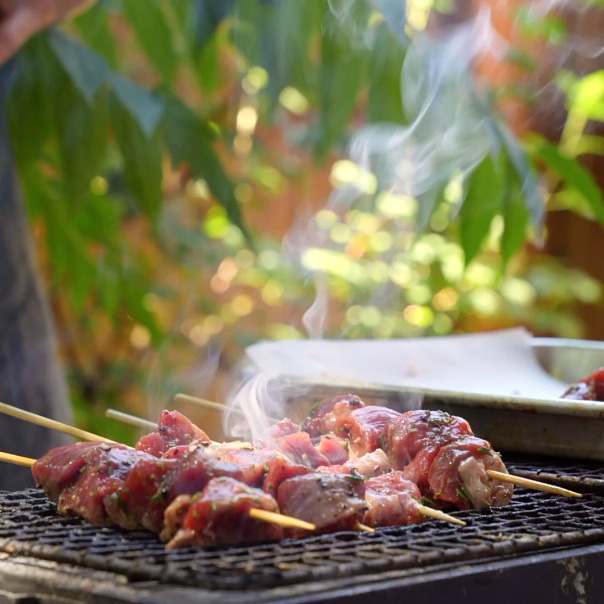Wine And Barbecue
When the weather warms, barbecue beckons. The sweet smell of smoke soars above neighborhoods all over the country as outdoor cooks migrate to their backyards to kindle those slow fires and shepherd meats on their gentle journey to smoky tenderness. It’s the best time of year.Jordan Mackay, author of the Franklin Barbeque cookbooks, is specifically talking about barbecue, not grilling. Both are wonderful, he says, but not the same thing. While both involve cooking with combustion, grilling is about cooking things, often quickly, directly over coals or flames. Barbecue is all about low and slow cooking, where proteins are gradually cooked in a fire-driven oven filled with smoke. Grilled items might offer a tinge of smoke or char, but barbecue glows with profound, smoky depths.

Beverage Pairing
In discussions of barbecue’s classic beverage pairings, wine isn’t generally considered in the first tier, appearing behind the usual suspects: beer and bourbon (or rye). This is a shame, as wine and barbecue have much in common. Both are among the world’s greatest “slow foods.” That is, if you’re making either of them, you have to wait a good while before they’re fit for consumption. Both wine and barbecue are methods of preservation, utilizing distinct techniques to delay spoilage and enable more extended storage. Winemaking and barbecue also share an intimate connection with wood.
Ironically, the wood factor is the connective tissue that many people use when pairing wine with barbecue – a grave mistake. The oak in wine has a profoundly different character than the wood in barbecue (often oak, but sometimes hickory, mesquite, or fruit woods), and the two do not play well together, sort of like rival siblings. The wood flavor in wine originates from barrels, which are made of toasted oak and impart a taste of toast, char, spice, and caramelized vanilla sweetness. These soft, sweet flavors are antithetical to the barbecue’s deep, peppery, savage smokiness, which comes from wood that is not gently toasted, but instead fully incinerated on its way to becoming smoke. So, avoid polished, slick, explicitly okay wines with barbecue; between them is a cultural gulf that can’t be bridged.
High-alcohol wines, even if well-balanced, also tend to fail. The mass and intensity of both wine and barbecue sparks a territorial dispute in the mouth, and neither side wins. This means adios to many Shiraz, Zins, Petite Sirahs, and even most Châteauneuf-du-Papes – wines most often considered classic barbecue pairings. Green-flavored wines are also a challenge. Smoking meats with logs that are too green (unseasoned) yields bad results – heavy, dirty smoke and off-flavors. Likewise, the punchy vegetal green notes of certain white wines suggest freshly cut, unseasoned logs and offend the burnished flavors of true barbecue. So, save your Vinho Verde, Sauvignon Blanc, and Grüner Veltliner for a salad course.
So, what works? That, of course, depends on what you’re eating. Think about unctuous, fall-off-the-bone spareribs and fork-tender piles of pulled pork. White wine can be a thing of beauty here. Look for fruit-driven, high-acid wines with hints of nuts. Italian white wines, in the style of Massican, can work wonders – whites from Friuli or Alto Adige, and even Campania and Sicily. Spanish white wines often work well too. These wines play counterpoint to the vinegar – and mustard-based sauces people like with smoked pork. Ripe, fruit-forward Riesling is excellent. Champagne also works well, if not too toasty. Krug is out because it can be too toasty and rich, but fresh and fruity styles fit right in.
Rose is always a great option, as it often toes the line between cheerful fruit and savory undertones. Additionally, its versatility allows it to pair well with smoked chicken, pork, beef, and various types of sausage. The fruit in rose counterbalances the intensity of pepper and smoke, which are often found in many great barbecue dishes. Plus, rose likes to be gulped cold, making it perfect for a summer cookout.
Reds are trickier than you’d think – the dark, smoky pepper flavor of lots of barbecue requests pure, properly ripe red fruit flavors. The wine should be driven, structured, and layered with flavor to hold its own against the meat. I happen to love a feral, blackberry-scented Syrah, which pairs naturally with barbecue, thanks to its notes of pepper, smoke, iron, and blood. Cabernet Sauvignon often works well, too, provided it isn’t explicitly oaky or jammy and overripe. Classic New World Cabernets made in a “classic” style with red fruit and freshness are great, and if available, try to pull the cork on some bottles with a few years of age on them. Red-fruited Italian wines like Chianti and Etna Rosso also work well, but a semi-sweet, frizzante Lambrusco may be the best pairing of all. Certainly, don’t shy away from tannic wine – barbecue’s fatty unctuousness adores a backyard brawl with a big red’s loudmouthed, grippy tannin.
Some final points may seem self-evident, but are worth remembering. Serve reds at cellar temp or with a slight chill. It’s very easy to forget this in summer, when wine bottles heat up quickly. Also, barbecue is meant to be eaten with fingers, so leave your expensive stems on the shelf unless you like scrubbing grubby Zaltos. Finally, barbecue is an escape, a primal journey outside of what we usually eat. So, try a handful of different wines at once, and feel free to bounce among them in whatever order you please. No food is more self-styled than barbecue, and your wine-drinking should be the same.
Image: Lamb skewers on a backyard grill. The classic Italian grigliata, or barbeque. Photo by Evan Roscoe, cooking by Sara Hauman.
